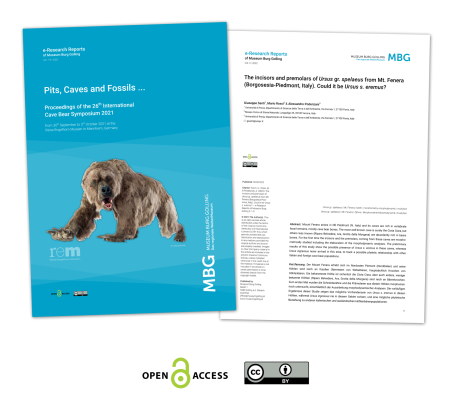Die »e-Research Reports of Museum Burg Golling« dienen als rein elektronisches Publikationsformat einer raschen Veröffentlichung aktueller interdisziplinärer Forschungsergebnisse zur regionalen Natur- und Kulturgeschichte. Alle Artikel erscheinen unter einer Creative-Commons-Lizenz (CC-BY 4.0) und sind im Sinne der »Berlin Declaration on Open Access to Knowledge in the Sciences and Humanities« im Open Access kostenlos zugänglich.
e-Research Reports

Vol. 13: The fossil bear remains from the Hennenkopf Cave (Steinernes Meer, province Salzburg, Austria)
Döppes, D., Kavcik-Graumann, N., Cech, P., Pavuza, R., Lindauer, S., Friedrich, R., Stockhammer, J., Rosendahl, W. & Rabeder, G. (2024): The fossil bear remains from the Hennenkopf Cave (Steinernes Meer, province Salzburg, Austria). – e-Research Reports of Museum Burg Golling 13: 1-12.
Vol. 12: The cave bear fauna of the cave Schottloch (Dachstein Mountains, Austria)
Kavcik-Graumann, N., Alberti, F., Döppes, D., Friedrich, R., Stockhammer, J., Lindauer, S., Hofreiter, M. & Rabeder, G. (2023): The cave bear fauna of the cave Schottloch (Dachstein Mountains, Austria). – e-Research Reports of Museum Burg Golling 12: 1-7.
Vol. 11: Cave bears from Grotta del Bandito (Piedmont-Northern Italy). The final scenario.
Santi, G., Rossi, M. & Indelicato, M. (2023): Cave bears from Grotta del Bandito (Piedmont-Northern Italy). The final scenario. – e-Research Reports of Museum Burg Golling 11: 1-20.
Vol. 10: Cave bear skulls from Buco del Frate (Brescia, N. Italy). First morphometric analysis.
Indelicato, M., Rossi, M. & Santi, G. (2023): Cave bear skulls from Buco del Frate (Brescia, N. Italy). First morphometric analysis. – e-Research Reports of Museum Burg Golling 10: 1-6.
Vol. 9: New subfossil findings of wisent (Bos bonasus) in caves of the Northern Calcareous Alps (Upper Austria).
Schaer, T., Döppes, D., Nagel, D., Lindauer, S. & Rabeder, G. (2022): New subfossil findings of wisent (Bos bonasus) in caves of the Northern Calcareous Alps (Upper Austria). – e-Research Reports of Museum Burg Golling 9: 1-5.
Vol. 8: Cave bear cubs (Ursus spelaeus eremus) from the Potentialschacht at the Hochschwab massif (Styria, Austria).
Kavcik-Graumann, N., Alberti, F., Döppes, D., Friedrich, R., Lindauer, S., Plan, L., Stockhammer, J., Withalm, G. & Rabeder, G. (2022): Cave bear cubs (Ursus spelaeus eremus) from the Potentialschacht at the Hochschwab massif (Styria, Austria). – e-Research Reports of Museum Burg Golling 8: 1-5.
Vol. 7: The cave bears from the Grotta dell’Orso near Gabrovizza (Trieste, Italy). Fossil bear remains of the collection Ludwig Karl Moser at the Natural History Museum Vienna.
Kavcik-Graumann, N., Alberti, F., Döppes, D., Fabbricatore, A., Friedrich, R., Hofreiter, M., Lindauer, S., Rosendahl, W. & Rabeder, G. (2022): The cave bears from the Grotta dell’Orso near Gabrovizza (Trieste, Italy). Fossil bear remains of the collection Ludwig Karl Moser at the Natural History Museum Vienna. – e-Research Reports of Muse-um Burg Golling 7: 1-7.
Vol. 6: The lower first molar (m1) of Ursus gr. spelaeus from Valsolda (Lombardy, Italy): Morphometry and morphodynamic analyses and considerations on the evolutionary step.
Indelicato, M., Rossi, M. & Santi, G. (2022): The lower first molar (m1) of Ursus gr. spelaeus from Valsolda (Lombardy, Italy): Morphometry and morphodynamic analyses and considerations on the evolutionary step. – e-Research Re-ports of Museum Burg Golling 6: 1-6.
Vol. 5: The incisors and premolars of Ursus gr. spelaeus from Mt. Fenera (Borgosesia-Piedmont, Italy). Could it be Ursus s. eremus?
Santi, G., Rossi, M. & Podenzani, A. (2022): The incisors and premolars of Ursus gr. spelaeus from Mt. Fenera (Borgosesia-Piedmont, Italy). Could it be Ursus s. eremus? – e-Research Reports of Museum Burg Golling 5: 1-9.
Vol. 4: The Geisloch, a well preserved hypogene cave: statistical analysis of pronounced glacial speleothem damage and first U/Th dating of cave bear remains to older than 80 ka BP (Oberfellendorf, Franconian Alb, Germany).
Kempe, S., Fenzlein, R. & Schabdach, H. (2022): The Geisloch, a well preserved hypogene cave: statistical analysis of pronounced glacial speleothem damage and first U/Th dating of cave bear remains to older than 80 ka BP (Oberfellendorf, Franconian Alb, Germany). – e-Research Reports of Museum Burg Golling 4: 1-10.
Vol. 3: The Binghöhle, an epigene cave of Pleistocene origin and its history revealed by U/Th dating (Streitberg, Franconian Alb, Bavaria, Germany).
Kempe, S., Wiesler, S. V. & Huhn, K. (2022): The Binghöhle, an epigene cave of Pleistocene origin and its history revealed by U/Th dating (Streitberg, Franconian Alb, Bavaria, Germany). – e-Research Reports of Museum Burg Golling 3: 1-11.
Vol. 2: Investigating cave bear remains - an overview on methods with focus on radiocarbon dating and stable isotopes.
Lindauer, S., Knipper, C., Döppes, D., Knapp, H., Friedrich, R. & Rosendahl, W. (2022): Investigating cave bear remains – an overview on methods with focus on radiocarbon dating and stable isotopes. – e-Research Reports of Museum Burg Golling 2: 1-20.
Vol. 1: Passion to Quaternary palaeontology, geology and speleology: Professor Rudolf Musil (1926-2022).
Roblíčková, M. (2022): Passion to Quaternary palaeontology, geology and speleology: Professor Rudolf Musil (1926-2022). – e-Research Reports of Museum Burg Golling 1: 1-5.